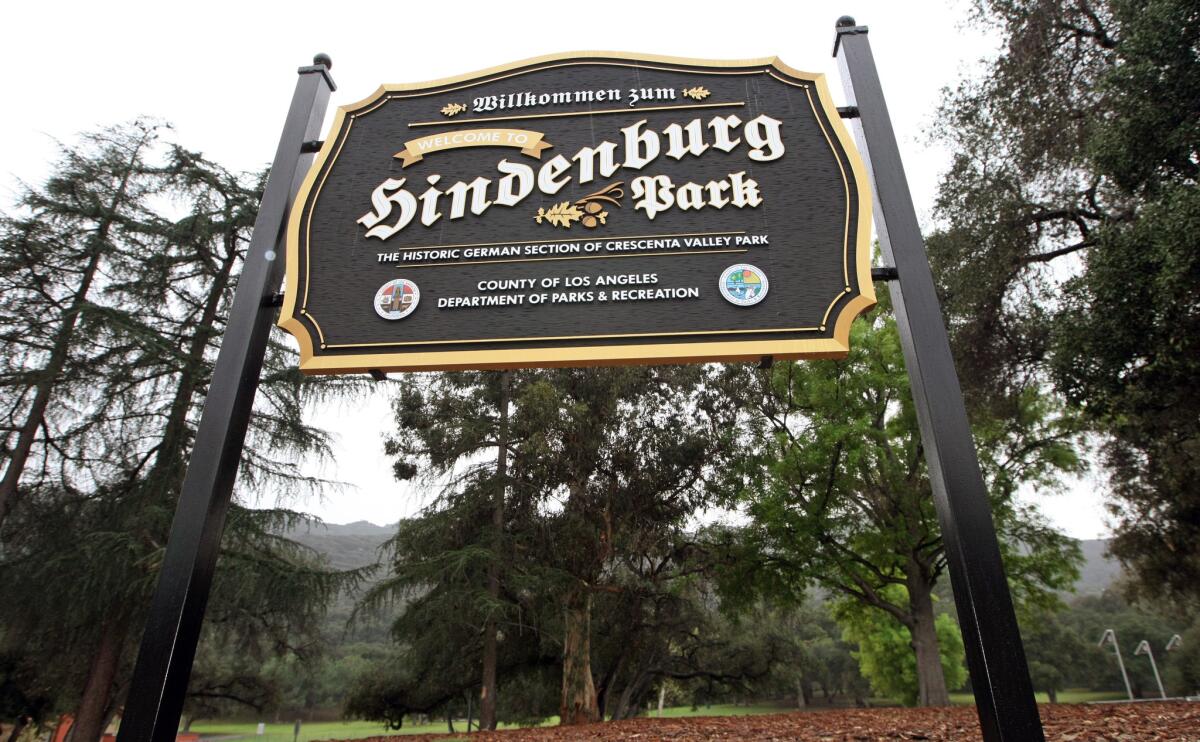County commissioners vote to remove welcome sign from Hindenburg Park

In February, Los Angeles County put up a sign for Hindenburg Park, which has been at the west end of Crescenta Valley Park since it was purchased by the county in 1958. The sign was paid for the Tri-Centennial Foundation, a German heritage organization.
A wooden sign welcoming visitors to Hindenburg Park in La Crescenta will soon be removed and replaced with another sign that will honor the German American ties to the park but not mention Hindenburgâs name, following a decision by the Los Angeles County Commission on Human Relations on Monday.
Nine commissioners voted to take down the sign, while one, Ashlee Oh, abstained.
NEWSLETTER: Stay up to date with whatâs going on in your community>>
The commission began weighing the issue in March after the Los Angeles County Parks and Recreation Department received complaints about the sign, which reads âwillkommen sum,â meaning âwelcome toâ followed by âHindenburg Park.â
Paul Von Hindenburg was a German military general during World War 1 who went on to become president of Germany and who appointed Adolf Hitler to be a chancellor, a move that some historians say Hindenburg was pressured to make a year before his death, but the appointment led to Hitlerâs rise to power.
The parks and recreation department installed the sign in February at the corner of Honolulu and Dunsmore avenues in Crescenta Valley Park after the Tri-Centennial Foundation, run by chairman Hans Eberhard, paid for the Hindenburg sign to acknowledge that portion of the park as a historic German American site.
Shortly after Hindenburgâs death in 1934, private owners of the property named that part of the park after him. A bust of Hindenburg was displayed in the park, along with one of Ludwig Van Beethoven, according to a county report. The area also hosted the first Oktoberfest in Southern California, and was often where local German Americans gathered for social events.
By the late 1930s, the park was the site of Nazi rallies.
After the sign went up in February, it almost immediately ignited controversy among residents who found it offensive.
In appealing to the commission to remove the sign, 69-year old Rancho Cucamonga resident Don Brostoff, who grew up in La Crescenta between 1947 and 1974, recalled attending Boy Scout meetings and playing baseball at the park as a boy..
His grandparents, however, avoided the park.
âMy grandparents, who were Jewish, would never go there because the activities in that park were well known,â he said.
Join the conversation on Facebook >>
When the park was sold to Los Angeles County in the late 1950s, the busts of Hindenburg and Beethoven were removed.
County officials dedicated that portion of the park to Hindenburg in 1992, and a plaque identifying the area as Hindenburg Park remains there today.
Controversy over the new sign led to a public hearing on April 7, which attracted 120 people and 47 speakers who gave their input on whether the sign should remain or not. County officials said residents at the meeting who opposed the sign compared to those who supported it was three to one.
For his part, Eberhard said he is disappointed by the commissionâs decision.
âYou try to do something nice and then thereâs somebody that throws rocks at you. It was always known as the Hindenburg Park,â he said. âWeâre not trying to promote the man, Hindenburg. Weâre trying to promote the history of the park as a German American site. I think some of the pictures floating around today [of the Nazi rallies] give the impression the park was Nazi headquarters. It was not.â
Jason Moss, executive director of the Jewish Federation of the Greater San Gabriel and Pomona Valleys â which sought the signâs removal â was pleased by not only the commissionâs decision to take down the sign, but applauded their suggestion that a task force of local stakeholders work together to create a new sign that will tell both the positive and negative events that have occurred in the park.
âPeople can now at least acknowledge [the history] and learn from it,â Moss said after the commission meeting.
Eberhard said he will plan to be part of the group that will work to create the new sign, which will ultimately be approved by and paid for by the parks and recreation department.
Eagle Rock resident Mona Field also opposed the Hindenburg sign and collected roughly 300 signatures through an online petition from nearby residents to support its removal.
She said she hopes that the recent events may change the process by which privately funded signs are approved if they are displayed in public places.
âI was hoping that out of this would come some protocols for the future so there is a process when a private group says, âWe want to do something,â thereâs public input,â Field said.
--
Kelly Corrigan, [email protected]
Twitter: @kellymcorrigan
